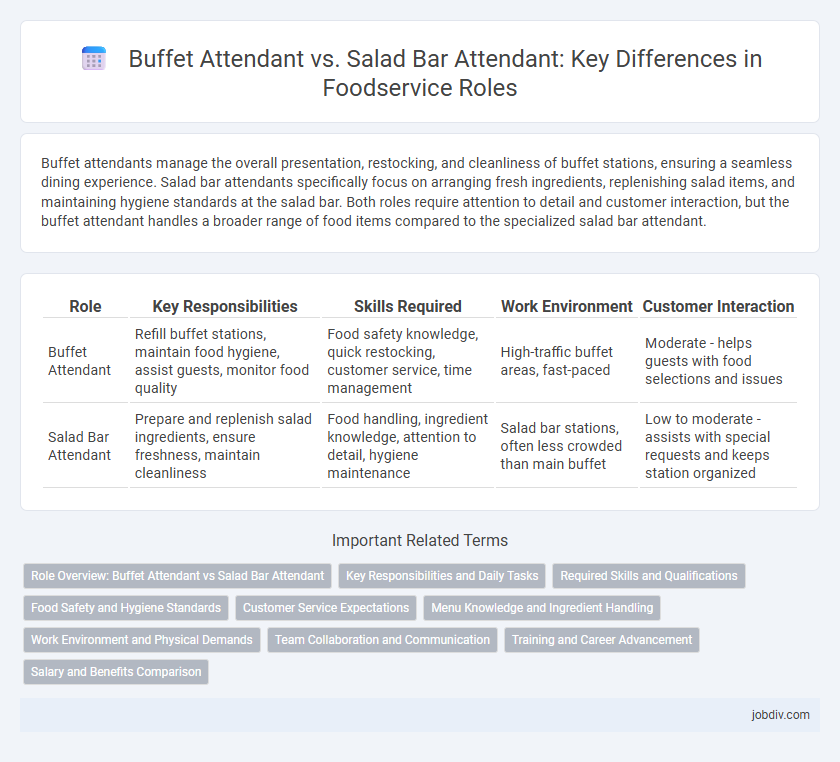Buffet attendants manage the overall presentation, restocking, and cleanliness of buffet stations, ensuring a seamless dining experience. Salad bar attendants specifically focus on arranging fresh ingredients, replenishing salad items, and maintaining hygiene standards at the salad bar. Both roles require attention to detail and customer interaction, but the buffet attendant handles a broader range of food items compared to the specialized salad bar attendant.
Table of Comparison
| Role | Key Responsibilities | Skills Required | Work Environment | Customer Interaction |
|---|---|---|---|---|
| Buffet Attendant | Refill buffet stations, maintain food hygiene, assist guests, monitor food quality | Food safety knowledge, quick restocking, customer service, time management | High-traffic buffet areas, fast-paced | Moderate - helps guests with food selections and issues |
| Salad Bar Attendant | Prepare and replenish salad ingredients, ensure freshness, maintain cleanliness | Food handling, ingredient knowledge, attention to detail, hygiene maintenance | Salad bar stations, often less crowded than main buffet | Low to moderate - assists with special requests and keeps station organized |
Role Overview: Buffet Attendant vs Salad Bar Attendant
Buffet attendants manage the setup, replenishment, and cleanliness of a wide variety of food stations, ensuring guests have a seamless dining experience across multiple cuisines. Salad bar attendants specialize in maintaining the freshness, presentation, and sanitation of salad ingredients, often tailoring offerings to dietary preferences and seasonal availability. Both roles require attention to detail, food safety knowledge, and customer service skills but differ in the scope of food variety and service interaction.
Key Responsibilities and Daily Tasks
Buffet attendants manage food presentation, replenish dishes, and maintain cleanliness to ensure a seamless dining experience, while salad bar attendants focus specifically on preparing, arranging, and restocking fresh vegetables, dressings, and toppings. Buffet attendants monitor food quality and assist guests with service, whereas salad bar attendants emphasize hygiene and portion control to prevent waste. Both roles require timely restocking and adherence to food safety regulations in high-traffic foodservice environments.
Required Skills and Qualifications
Buffet attendants must possess strong customer service skills, attention to detail, and the ability to efficiently manage food replenishment while maintaining cleanliness. Salad bar attendants require knowledge of food safety protocols, proficiency in food preparation, and familiarity with dietary restrictions such as allergens and vegan options. Both roles demand physical stamina, teamwork capabilities, and basic math skills for inventory tracking and portion control.
Food Safety and Hygiene Standards
Buffet attendants and salad bar attendants both play critical roles in maintaining food safety and hygiene standards by regularly sanitizing serving areas and ensuring proper food temperature control. Buffet attendants monitor multiple hot and cold dishes to prevent cross-contamination, while salad bar attendants focus on fresh produce handling and frequent replacement of perishable items to minimize bacterial growth. Compliance with strict handwashing protocols and wearing gloves are essential practices for both roles to uphold health codes and protect customers from foodborne illnesses.
Customer Service Expectations
Buffet attendants are expected to monitor food levels, maintain cleanliness, and assist customers with serving utensils, ensuring a seamless dining experience. Salad bar attendants prioritize the freshness of ingredients, promptly restocking items and accommodating special dietary requests to enhance customer satisfaction. Both roles require attentiveness, friendly interaction, and efficient service to meet high customer service standards in foodservice environments.
Menu Knowledge and Ingredient Handling
Buffet attendants require extensive menu knowledge to assist guests with diverse food options and accommodate dietary restrictions, ensuring smooth service flow. Salad bar attendants focus on ingredient handling with precision, maintaining freshness, proper portioning, and hygiene standards for customizable salads. Both roles demand detailed understanding of ingredients, but buffet attendants emphasize overall menu familiarity while salad bar attendants specialize in fresh produce management.
Work Environment and Physical Demands
Buffet attendants often work in fast-paced, high-traffic dining areas where they must quickly replenish food trays and maintain cleanliness, requiring long periods of standing and frequent bending or lifting. Salad bar attendants typically operate in smaller, more controlled environments, focusing on fresh ingredient preparation and presentation, which demands repetitive cutting, chopping, and precise hand movements. Both roles require strong stamina and the ability to work efficiently during peak meal times while adhering to strict hygiene standards.
Team Collaboration and Communication
Buffet attendants and salad bar attendants both rely heavily on effective team collaboration and communication to ensure smooth service flow and customer satisfaction in foodservice environments. Buffet attendants coordinate with kitchen staff and servers to manage food replenishment and cleanliness, while salad bar attendants communicate constantly with chefs and inventory teams to maintain freshness and ingredient availability. Strong teamwork and clear communication between these roles minimize wait times and enhance the overall dining experience.
Training and Career Advancement
Buffet attendants receive training focused on food safety, portion control, and customer service, while salad bar attendants specialize in proper handling of fresh produce, allergen awareness, and presentation techniques. Career advancement for buffet attendants often leads to supervisory roles within dining services or catering, whereas salad bar attendants may progress to food quality control or nutrition consultant positions. Both roles benefit from certifications in food safety and hospitality management to enhance career growth.
Salary and Benefits Comparison
Buffet attendants typically earn an average hourly wage ranging from $11 to $15, reflecting responsibilities such as replenishing food stations and maintaining cleanliness, while salad bar attendants generally earn between $10 and $14 per hour, focusing on preparing and organizing salad ingredients. Benefits for both roles may include employee meals, flexible schedules, and sometimes health insurance, but buffet attendants often qualify for more comprehensive packages due to the higher demand and complexity of their duties. Wage variations depend on the establishment size, geographic location, and experience level, with buffet attendants generally receiving slightly higher compensation and benefits.
Buffet Attendant vs Salad Bar Attendant Infographic

 jobdiv.com
jobdiv.com